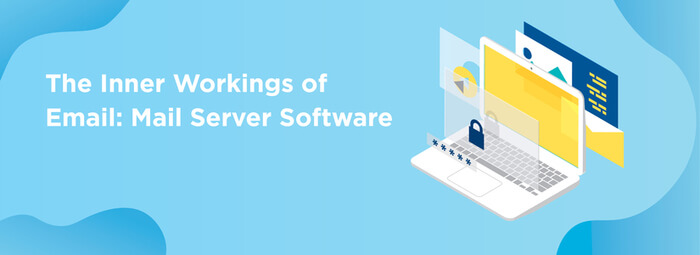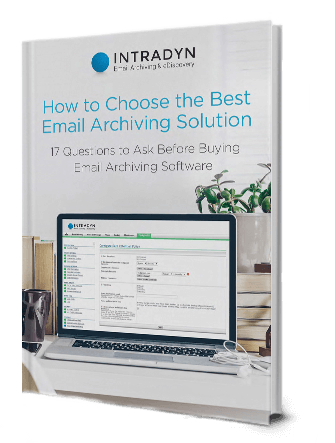The Inner Workings of Email: Mail Server Software

When you send an email, you probably don’t spend much time thinking about what’s going on behind the scenes that makes it possible for that message to get from Point A to Point B — you just click a button, and you’re done. In reality, sending and receiving email isn’t as simple as it seems: There are multiple components necessary to send a message through cyberspace to its intended recipient. Perhaps the most important of these components is the mail server.
In this blog post, we’ll take a high-level look at mail server software — what it is, how it works and more.
What is a Mail Server?
A mail server, also known as an email server, is a computer system that acts as the main point of distribution through which all email is sorted, routed and delivered. To simplify things, think of a mail server as being analogous to the post office or even your friendly neighborhood mailman.
Mail servers are able to distribute email using standard email protocols, such as SMTP, IMAP and POP3 (more on these momentarily). End users can access emails sent using a mail server one of two ways: via a cloud-based email service — also known as webmail — or an on-premises email client.
With an email service, you send, receive and read emails using a web browser and a web-based interface; popular examples of email services include Gmail and Yahoo. An email client, by comparison, is a software program that you install on your computer; this program provides the interface through which you access, view and manage emails. Popular examples of email clients include Outlook and Thunderbird.
How Does Mail Server Software Work?
As mentioned above, mail server software relies on email protocols in order to send and receive messages. An email protocol is a type of communication protocol — that is, an established set of rules that defines the structure, syntax and semantics of any data transmitted between two entities. In this case, those entities would be mail servers.
Most email server solutions use one or more of the following protocols:
- Simple Mail Transfer Protocol (SMTP): So-named because it transfers data over the internet from one server to another, SMTP is a form of TCP/IP protocol used specifically to send emails. Since SMTP is unable to queue messages at the receiving end, it is often used in conjunction with either IMAP or POP3.
- Internet Message Access Protocol (IMAP): IMAP is an email protocol that enables end users to access email on a remote web server via a local client without downloading messages from the server or storing them on their computer. As a result, IMAP makes it easy for users to access their email from any device and from anywhere in the world. IMAP does not offer built-in offline accessibility; however, users can convert IMAP backups into PST files for online access.
- Post Office Protocol (POP3): POP3 is an email protocol used to receive emails from a remote server to a remote email client. Compared to IMAP, POP3 downloads messages from an end user’s email service to their device; once the download is complete, the messages are automatically deleted from the email service. For this reason, once an email message is downloaded, it can only be accessed from that same device. Since POP3 downloads messages, users are able to read emails regardless whether they’re online or offline; it also frees up valuable space on the mail server.
Mail server software also requires a mail transfer agent and a mail delivery agent to operate. A mail transfer agent, also known as a message transfer agent, is software that transfers electronic messages from one computer to another using SMTP. A mail delivery agent is a software program that receives messages from a mail transfer agent, sorts those messages and delivers them to the local recipient’s inbox. Most mail servers also include some sort of spam filtering and anti-virus functionality
Does It Make Sense to Host Your Own Mail Server?
When it comes to running email server software, businesses both large and small have the option to either self-host or outsource hosting to a third-party provider.
With self-hosting — that is, storing emails on your own personal mail server — you’re responsible for owning and operating your own mail server software. Although this comes with certain benefits, including greater privacy, security and control, email server software can be difficult to set up and maintain. Self-hosting is also expensive. In addition to requiring a major upfront investment, self-hosted servers require systems administrators to perform routine maintenance, and additional servers must be added over time in order to accommodate a business’ email hosting needs. For these reasons, self-hosting really only makes sense for enterprises that have the resources to run and maintain multiple email servers.
With third-party hosting, a hosting provider — that is, a company that owns multiple mail servers — rents out their servers to businesses. Third-party hosting is popular for its affordability. There are multiple free hosting services for custom domains on the market, though they’re typically ad-heavy and lack much of the functionality that paid services offer. Paid hosting services comes with a wider range of features, including spam filtering, online storage, email backup and more, and hosting providers are completely responsible for managing and maintaining their own servers. The biggest risk to using third-party hosting is potential security breaches. Businesses that use third-party hosting don’t have direct control over their email servers, which can leave them more prone to cyberattacks. Third-party hosting is most popular amongst small-and-medium-sized business.
As with all things, the decision whether you choose to host your own mail server software or outsource to a third-party provider should be based on the what resources you have at your disposal and the particular needs of your organization.
How to Choose the Right Mail Server Software
Should you choose to host your own mail server software, it’s important that you take the time to identify the right email server solution. Here are a few criteria for evaluation that you can use to support your search:
- Is this solution on-premise or cloud-based?
- How difficult will it be to manage this solution?
- How complex will it be to add new users or change existing ones?
- How challenging is it for end users to set up their preferred email client?
- Does this solution include webmail?
- What other features are included?
- Does this solution offer built-in email archiving capabilities? If not, how difficult would it be to integrate this solution with an email archiving platform?
Although Microsoft Exchange is generally considered the gold standard in mail server software, the reality is that there’s really no “bad” option — it all depends on your internal IP infrastructure, your IT resources, your price point and your requirements.
Complete List of Mail Servers
|
Server OS Support | Features | Storage |
|
|
|
|
|
|
|
|
|
|
|
|
|
|
|
|
|
|
|
|
|
|
n/a | |
| Cyrus IMAP |
|
|
Sieve and Database
|
| Dovecot |
|
|
Sieve and Database |
| Eudora Internet Mail Server | Mac OS |
|
n/a |
| Exim |
|
**POP3 and IMAP available through Dovecot |
Sieve and Database |
| FirstClass |
|
|
Sieve and Database |
| Gordano Messaging Suite |
|
|
Database |
| GroupWise |
|
|
Sieve and Database |
| Halon | Linux/Unix |
|
Database |
| Haraka |
|
|
Database |
| hMailServer | Windows |
|
Database |
| IceWarp |
|
|
Database |
| Ipswitch Progress IMail Server | Windows |
|
n/a |
| Kerio Connect |
|
|
Sieve |
| Kolab | ü Linux/Unix |
|
Sieve and Database |
| Kopano | ü Linux/Unix |
|
SQL Database |
| MailSite | ü Windows |
|
Sieve and Database |
| Mailtraq | ü Windows |
|
Sieve and Database |
| MDaemon | ü Windows |
|
Database |
| Mercury Mail Transport System | ü Windows |
|
n/a |
| Microsoft Exchange Server | ü Windows |
|
Sieve (w/ 3rd party support) and Database |
| Netgovern |
|
|
Database |
| OpenSMTPD | Linux/Unix |
|
Database (through custom backends) |
| Open-Xchange | Linux/Unix |
|
Database |
| Oracle Communications Messaging Server | Linux/Unix |
|
Database |
| Postfix |
|
**POP3 and IMAP available through Dovecot |
Database |
| qmail |
|
** IMAP available through Dovecot |
Database (cdb) |
| Scalix | Linux/Unix |
|
Database |
| Sendmail |
|
**POP3 and IMAP available through Dovecot |
n/a |
| WinGate | Windows |
|
n/a |
| Zarafa | Linux/Unix |
|
SQL Database |
| Zentyal | Linux/Unix |
|
Database |
| Zimbra |
|
|
Sieve and Database |
How Can Archiving Enhance Mail Server Software Performance?
One of the leading causes of poor mail server performance is the high volume of emails glutting up storage. Although emails, themselves, don’t consume a significant amount of storage space, email attachments — documents, images, spreadsheets, presentations and so on — do.
Typically, as attachments are sent back and forth, copies of them are made and saved to the server, eating up even more space. And whenever employees save emails as PST files, it further contributes to the problem. If left unchecked, this high disk utilization can cause your email server software to slow down.
In an ideal world, you’d be able to spin up new servers whenever you ran out of space, but this isn’t financially or logistically feasible for most organizations. There’s also the option to enforce quota limits, but you always run the risk of employees not observing those limits.
Email archiving software can remedy this issue by enabling you to store emails, attachments, copies of attachments and PST files all within a single, secure archive rather than on your email server. When implemented properly, an email archiving solution can even automatically capture incoming and outgoing emails in real time, storing them and indexing their content, so you never have to think twice. This removes much of the strain from your server, enabling it to run at peak performance levels.
If you’re in the market for an archiving solution, we recommend that you start your search with Intradyn. Our Email Archiver includes an extensive feature set, including eDiscovery capabilities, advanced analytics and reporting and an intuitive user interface, to optimize mail server software performance.
To learn more about Intradyn, watch our on-demand demo, or contact us today to talk to an archiving specialist.

